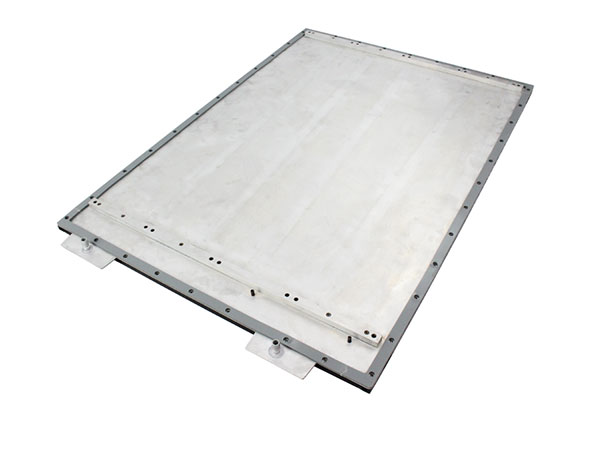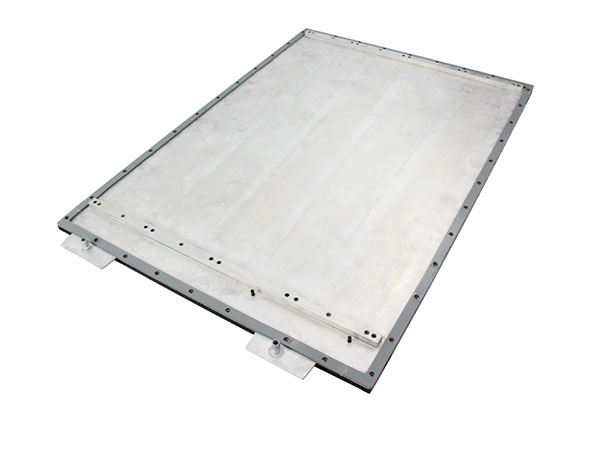
The heat dissipation efficiency of liquid cooling plates is significantly better than that of traditional air cooling, mainly reflected in the following core dimensions:
The essential differences in heat transfer mechanisms
Air cooling: It relies on air flow to carry away heat. The specific heat capacity of air (about 1.005 kJ/kg · K) and the thermal conductivity (about 0.026 W/m · K) are relatively low, and its heat dissipation capacity is limited. When the power density of the heat source exceeds 50 W/cm², the air-cooling efficiency drops sharply. It is necessary to significantly increase the fan speed (the noise rises accordingly) or increase the heat dissipation area (due to volume limitations).
Liquid cooling plate: It uses liquid (such as water, oil) as the medium. Its specific heat capacity (water about 4.186 kJ/kg · K, oil about 2.0 kJ/kg · K) and thermal conductivity (water about 0.6 W/m · K, oil about 0.13 W/m · K) are much higher than those of air. Under the same flow rate, it can carry more heat. For instance, when 1 liter of water is raised by 1℃, it absorbs 3,500 times more heat than air, and its heat dissipation efficiency is increased by 10 to 100 times. It can easily handle ultra-high power density heat sources of 100 to 1000 W/cm² (such as AI chips and laser devices).
2. Temperature control accuracy and uniformity
Air cooling: Air flow is easily affected by the environment (such as air flow disturbance and dust accumulation), and the temperature difference on the surface of the heat source is usually > 5℃, which is difficult to meet the temperature control requirements of precision devices (such as lithium batteries, which require a temperature difference of ≤±2℃).
Liquid cooling plate: The liquid flows stably in a closed flow channel. By optimizing the flow channel design (such as microchannels, intertragically shaped structures), the surface temperature difference of the heat source can be achieved to be ≤±1℃, and even the local area temperature difference can be < 0.5℃ (such as the precise temperature control of quantum computing chips).

3. Comparison of noise and Energy efficiency
Air cooling: In high-power scenarios, large-sized fans or multi-stage fans are required. The noise level is usually over 60 dB (such as in server rooms), and the energy consumption of fans accounts for 5 to 10% of the total system power consumption (if the fan speed doubles, the energy consumption increases by 8 times).
Liquid cooling plate: It relies on a pump to drive the circulation of liquid. The noise of the pump is usually less than 40 dB (such as in the liquid cooling system of new energy vehicle batteries), and its energy consumption is only 1/5 to 1/3 of that of the same power air-cooling fan. For instance, when cooling a 10kW heat source, the power consumption of a liquid cooling pump is approximately 200W, while that of an air-cooling fan may exceed 1000W.
4. Volume and Space occupation
Air cooling: It requires the use of large heat dissipation fins and fans, making it bulky. For example, the volume of the air-cooled heat sink for cooling a 200W CPU can reach 1000 cm³, and it is necessary to reserve ventilation space in front of and behind the fan (accounting for more than 30% of the case volume).
Liquid cooling plate: Compact structure, its volume is only 1/3 to 1/5 of that of air cooling under the same heat dissipation power. For instance, the thickness of the microchannel liquid cooling plate can be less than 5mm, directly adhering to the surface of the chip, saving the internal space of the equipment (for example, the thickness of the liquid cooling module in a notebook computer is less than 10mm), and is particularly suitable for high-density integration scenarios (such as blade servers in data centers).
5. Adaptability to extreme scenarios
Air cooling: It is significantly affected by ambient temperature. In high-temperature environments (such as data centers in desert areas), the heat dissipation efficiency drops sharply, and additional air conditioning load is required (energy consumption increases by 20-30%).
Liquid cooling plate: It can independently control temperature through a closed-loop circulation system and is not affected by the external environment. For instance, in an environment with a low temperature of -40 ℃ or a high temperature of 85℃, the liquid cooling system can still maintain the stability of the heat source temperature (such as the charge and discharge efficiency retention rate of on-board batteries under extreme weather conditions being > 95%).